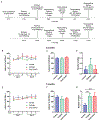Investigating the role of striatal dopamine receptor 2 in motor coordination and balance: Insights into the pathogenesis of DYT1 dystonia
- PMID: 33476687
- PMCID: PMC8165729
- DOI: 10.1016/j.bbr.2021.113137
Investigating the role of striatal dopamine receptor 2 in motor coordination and balance: Insights into the pathogenesis of DYT1 dystonia
Abstract
DYT1 or DYT-TOR1A dystonia is early-onset, generalized dystonia. Most DYT1 dystonia patients have a heterozygous trinucleotide GAG deletion in DYT1 or TOR1A gene, with a loss of a glutamic acid residue of the protein torsinA. DYT1 dystonia patients show reduced striatal dopamine D2 receptor (D2R) binding activity. We previously reported reduced striatal D2R proteins and impaired corticostriatal plasticity in Dyt1 ΔGAG heterozygous knock-in (Dyt1 KI) mice. It remains unclear how the D2R reduction contributes to the pathogenesis of DYT1 dystonia. Recent knockout studies indicate that D2R on cholinergic interneurons (Chls) has a significant role in corticostriatal plasticity, while D2R on medium spiny neurons (MSNs) plays a minor role. To determine how reduced D2Rs on ChIs and MSNs affect motor performance, we generated ChI- or MSN-specific D2R conditional knockout mice (Drd2 ChKO or Drd2 sKO). The striatal ChIs in the Drd2 ChKO mice showed an increased firing frequency and impaired quinpirole-induced inhibition, suggesting a reduced D2R function on the ChIs. Drd2 ChKO mice had an age-dependent deficient performance on the beam-walking test similar to the Dyt1 KI mice. The Drd2 sKO mice, conversely, had a deficit on the rotarod but not the beam-walking test. Our findings suggest that D2Rs on Chls and MSNs have critical roles in motor control and balance. The similarity of the beam-walking deficit between the Drd2 ChKO and Dyt1 KI mice supports our earlier notion that D2R reduction on striatal ChIs contributes to the pathophysiology and the motor symptoms of DYT1 dystonia.
Keywords: Cholinergic interneurons; Corticostriatal plasticity; DYT1/DYT-TOR1A dystonia; Dopamine D2 receptor; Medium spiny neurons.
Copyright © 2021 Elsevier B.V. All rights reserved.
Conflict of interest statement
Figures






Similar articles
-
Decreased number of striatal cholinergic interneurons and motor deficits in dopamine receptor 2-expressing-cell-specific Dyt1 conditional knockout mice.Neurobiol Dis. 2020 Feb;134:104638. doi: 10.1016/j.nbd.2019.104638. Epub 2019 Oct 13. Neurobiol Dis. 2020. PMID: 31618684 Free PMC article.
-
Characterization of the direct pathway in Dyt1 ΔGAG heterozygous knock-in mice and dopamine receptor 1-expressing-cell-specific Dyt1 conditional knockout mice.Behav Brain Res. 2021 Aug 6;411:113381. doi: 10.1016/j.bbr.2021.113381. Epub 2021 May 24. Behav Brain Res. 2021. PMID: 34038798 Free PMC article.
-
Diverse Mechanisms Lead to Common Dysfunction of Striatal Cholinergic Interneurons in Distinct Genetic Mouse Models of Dystonia.J Neurosci. 2019 Sep 4;39(36):7195-7205. doi: 10.1523/JNEUROSCI.0407-19.2019. Epub 2019 Jul 18. J Neurosci. 2019. PMID: 31320448 Free PMC article.
-
Functional pathology of neuroleptic-induced dystonia based on the striatal striosome-matrix dopamine system in humans.J Neurol Neurosurg Psychiatry. 2025 Jan 16;96(2):177-183. doi: 10.1136/jnnp-2024-334545. J Neurol Neurosurg Psychiatry. 2025. PMID: 39631787 Review.
-
Membrane defects and genetic redundancy: Are we at a turning point for DYT1 dystonia?Mov Disord. 2017 Mar;32(3):371-381. doi: 10.1002/mds.26880. Epub 2016 Dec 2. Mov Disord. 2017. PMID: 27911022 Review.
Cited by
-
Reversal of motor-skill transfer impairment by trihexyphenidyl and reduction of dorsolateral striatal cholinergic interneurons in Dyt1 ΔGAG knock-in mice.IBRO Neurosci Rep. 2021 Jun 12;11:1-7. doi: 10.1016/j.ibneur.2021.05.003. eCollection 2021 Dec. IBRO Neurosci Rep. 2021. PMID: 34189496 Free PMC article.
-
Emerging role of a systems biology approach to elucidate factors of reduced penetrance: transcriptional changes in THAP1-linked dystonia as an example.Med Genet. 2022 Aug 12;34(2):131-141. doi: 10.1515/medgen-2022-2126. eCollection 2022 Jun. Med Genet. 2022. PMID: 38835919 Free PMC article.
-
Altered Functional Brain Connectivity in Dyt1 Knock-in mouse models.Dystonia. 2025;4:13874. doi: 10.3389/dyst.2025.13874. Epub 2025 Feb 12. Dystonia. 2025. PMID: 40735249 Free PMC article.
-
Electrophysiological characterization of the striatal cholinergic interneurons in Dyt1 ΔGAG knock-in mice.Dystonia. 2022 Jul;1:10557. doi: 10.3389/dyst.2022.10557. Epub 2022 Jul 21. Dystonia. 2022. PMID: 36329866 Free PMC article.
-
Clinical implications of genetic polymorphisms in blepharospasm.Exp Ther Med. 2024 Jun 25;28(2):332. doi: 10.3892/etm.2024.12621. eCollection 2024 Aug. Exp Ther Med. 2024. PMID: 38979016 Free PMC article.
References
-
- Albin R, Young A, Penney J. The functional anatomy of basal ganglia disorders. Trends in neurosciences 1989; 12(10). - PubMed
-
- Aosaki T, Miura M, Suzuki T, Nishimura K, Masuda M. Acetylcholine-dopamine balance hypothesis in the striatum: an update. Geriatr Gerontol Int 2010; 10 Suppl 1: S148–57. - PubMed
-
- Asanuma K, Ma Y, Okulski J, Dhawan V, Chaly T, Carbon M, et al. Decreased striatal D2 receptor binding in non-manifesting carriers of the DYT1 dystonia mutation. Neurology 2005; 64(2): 347–9. - PubMed
-
- Augood SJ, Hollingsworth Z, Albers DS, Yang L, Leung JC, Muller B, et al. Dopamine transmission in DYT1 dystonia: a biochemical and autoradiographical study. Neurology 2002; 59(3): 445–8. - PubMed
Publication types
MeSH terms
Substances
Supplementary concepts
Grants and funding
LinkOut - more resources
Full Text Sources
Other Literature Sources
Molecular Biology Databases
Research Materials
Miscellaneous

